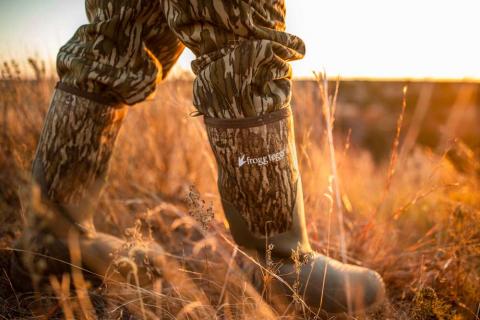Brad Fenson
Hunting away from home always feels like an adventure. No hunting adventure is complete without seeing different parts of the country, experiencing new species and harvesting game. Harvesting game while on an adventure is one thing, but getting it home is another. Getting fresh proteins from there to home can be challenging, but some planning can ensure that birds or big game make it home safely to grace your table.
Over the years, I've gone to great lengths to bring home thousands of pounds of wild game. Here are some tips and techniques to bring home everything from musk oxen and moose to tiny quail and wild turkeys.
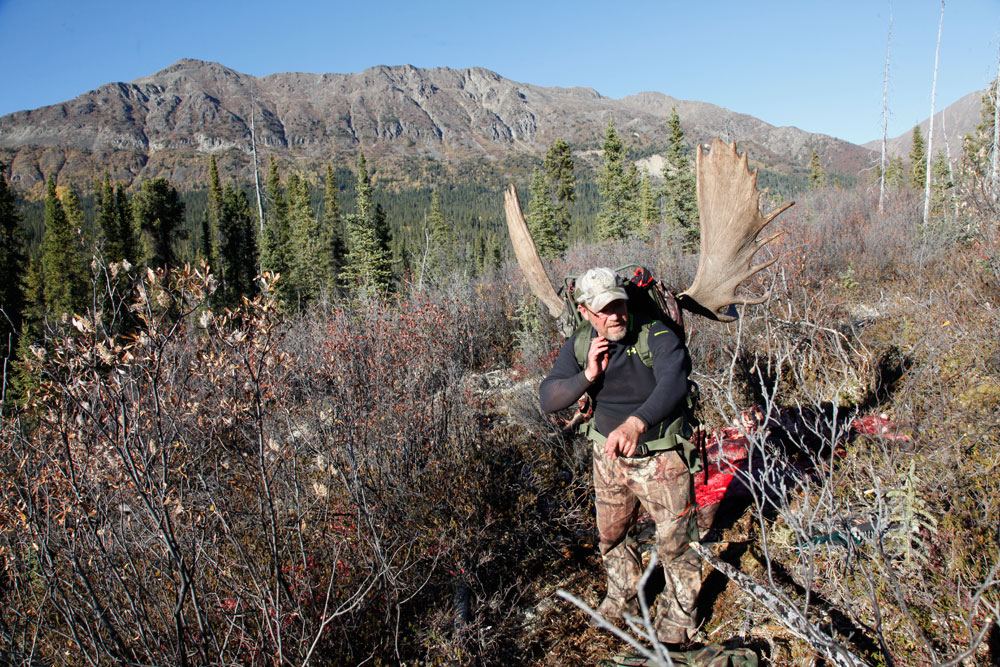
Freezer and Generator
A chest freezer is more efficient than a cooler filled with dry ice. If meat is cut and wrapped, or even placed in the freezer as quarters, then plugged in to create meatsicles, you have several days to get your bounty home. Ensure the freezer has a lock, so the lid cannot fly open during transport on the back of the truck or cold air escapes.
If there are stops along the way, the freezer is plugged in for the night to ensure the contents remain frozen. Trips to the Yukon have included a freezer and generator. Moose and caribou meat were frozen and transported home in the chest freezer. When the weather was hot, a generator ran the freezer while driving. Precautions were taken to ensure exhaust fumes could escape and heat didn't build up.
After several days of travel, the meat was unpacked at home and frost had not formed on any packages. The meat was still frozen solid.
Coolers
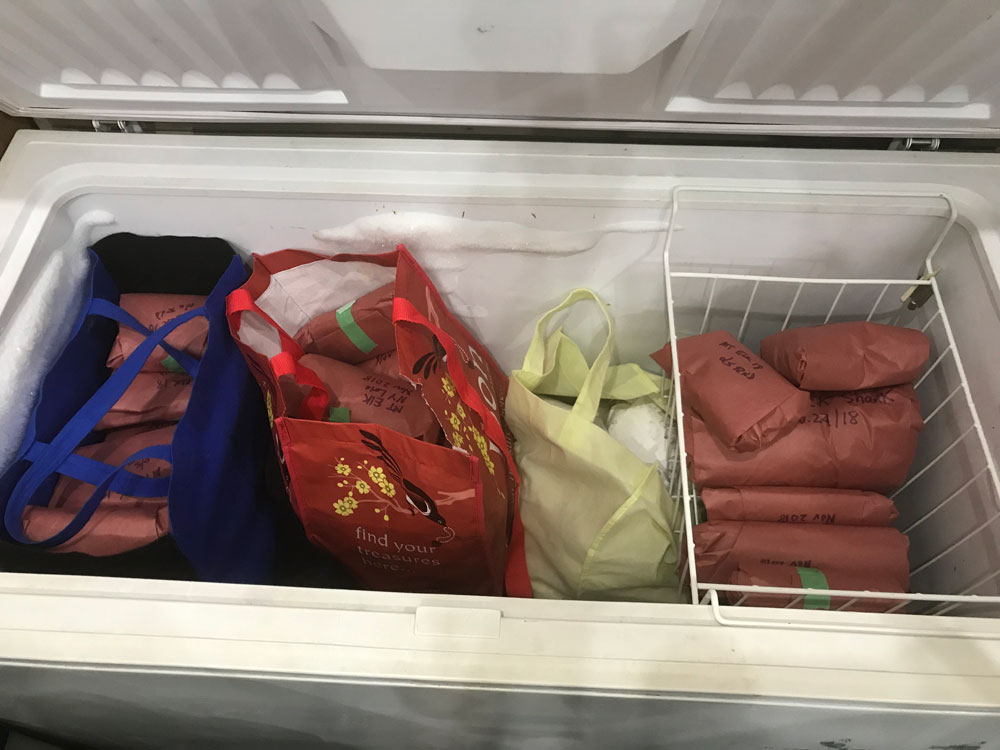
It isn't always feasible to take a chest freezer and generator on a hunting trip, so a good cooler is worth its weight in venison. Not all coolers are created equal. Finding one that keeps the contents cold or frozen and still provides enough room to put a significant amount of meat is critical.
Some coolers are fantastic at keeping the contents at the proper temperature. However, the walls are so thick that they are not practical. They are often so heavy that it takes two people to carry an empty. The weight makes these coolers expensive to ship long distances. Check insulation ratings, seals in the lid and capacity, and compare it with other prices. Every sportsperson needs a good cooler, and finding the perfect fit takes some investigation or trial and error.
The Cordova line of coolers is a good example of units that do what owners expect. The walls are narrow but well-insulated, allowing for more meat inside. The non-slip feet and a lid that locks open and out of the way for loading or unloading are excellent features. The latches close tight, allowing the cooler to hold full capacity. Furthermore, they are American-made.
Hard-walled, top-loading coolers are great for transporting processed frozen meat, and if you don't open the lid to peek, they will keep the contents frozen without compromise. The biggest mistake people make with coolers is opening them to check and see how the contents are doing. Trust the cooler and keep it closed.
Quick Cool
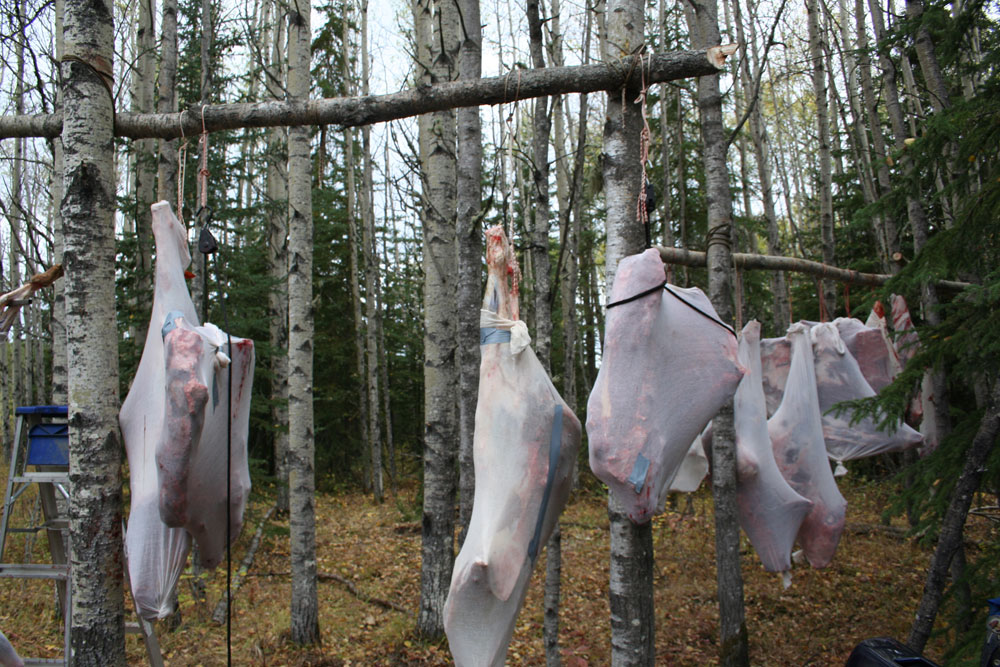
Hunters don't always have the luxury to butcher, wrap and freeze meat before heading home. On occasion, an animal is harvested hours before hitting the road. A cooler provides options to cool the meat to perfect travel temperature.
A deer can be cut into muscle groups or quarters and placed in the cooler. The air space around the meat is then filled with ice and water. The slurry will super cool the meat and allow you to get home where it can be dried and butchered. Wet is not an ideal medium for the meat, as moisture on proteins promotes bacterial growth. The cold temperatures will slow down bacterial growth, but clean and dry is always best. Soaking meat in ice water will also change the appearance, making it look lighter in color and washed out. Make sure the cooler seals tight or you will have a mess on your hands. This method can be a meat-saver but don't leave the meat products in the water for more than a day.
When Ice Works
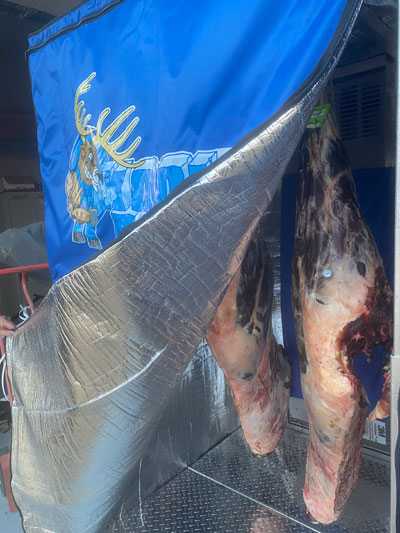
An Oklahoma outfitter taught me an excellent trick for beating the heat and the flies. I harvested a nice buck early in the day, and my guide field-dressed the deer but insisted on not skinning it. I was shocked but listened carefully to the proven techniques used for years in the camp.
The deer was opened from the bottom of the rib cage to the rectum and eviscerated. The hide was left intact. The deer hung head down in the shade with two 10-pound bags of ice inserted into the chest and abdomen. The ribs, backbone and legs worked like cooling rods to lower the temperature of the muscles. The hide worked like an insulator to trap the cold and, eventually, the ice stopped melting. A tarp wrapped tightly around the deer helped maintain the cold and kept insects at bay. The locals explained that the flies, ants and other pesky insects would attack the carcass quicker than we could deal with it if skinned, so the deer was super-cooled with ice. The bags of ice in the cavity are perfect for getting a deer home on a hot day. If you need to add more ice, stop at a local gas station and replenish anything that has melted. The cold penetrated the entire deer, and even the bones were cold to the touch when the hide was removed.
Bag Your Game
Many hunters prefer not to get meat wet and use game bags to keep the meat's surface clean and dry. When heat and potential spoilage are possible, use Koola Buck Antimicrobial Game Bags. The specialized bags reduce bacterial growth and provide extra time to plan for the meat. The game bags allow the meat access to the air to cool in a breeze or the shade. If travel schedules don't allow time to cool the meat thoroughly, a cooler and ice are options.
Ice in the bottom of the cooler, separated from meat with a plastic bag, waxed meat paper or a rack, will help maintain ideal temperatures. Drain any water that is created by melting ice and replenish the ice as required. You can leave the drain plug loose if you're in a place that's safe for fluids to drain. Turning and rotating the meat twice a day will ensure all pieces are adequately cooled. Dry ice works even faster but can be challenging to locate.
Soft-Sided Coolers
Big bulky coolers are not always an option, especially when air travel is involved. A soft-sided cooler is perfect for hauling meat home to share with the family. The AO family line of soft-sided coolers comes in several sizes and is available in Mossy Oak camouflage. The coolers are measured by how many canned beverages they hold, and the 36- or 48-can units are ideal for turkey, antelope, mule deer or just the prime cuts from an elk. In most cases, these soft-sided coolers will hold a limit of waterfowl with wings attached.
The AO brand seals tight, making them ideal for air travel. They will hold 50 pounds of meat, but 48 or 49 pounds would be suggested as a maximum to avoid overcharges with any airline. Check with airlines, but most do not allow dry ice, so freeze or super cool the meat and pack it tight in the cooler. If not fully frozen, put the meat in a sealable plastic bag as insurance against leakage. The cooler is too heavy to be considered a carry-on but is perfect for a checked bag. The smaller AO coolers are perfect for carry-on with things like a wild turkey or pheasant limit.
Cold Bags
Always try to keep in mind that an airplane cruising at 30,000 feet is likely to have an external temperature as low as -50°F. There have been many times when luggage was retrieved, and it was as cold as ice. If there are flights involved in getting home, there are many ways to package meat to ensure a safe trip.
Most grocery stores carry bags to keep cold or hot items in good condition for transport home. The foil-lined bags are silver and usually have blue and red writing to indicate temperature controls. The bags are only a dollar or two and are perfect for a day trip home, where game meat can be placed in the cold bags and put in checked luggage. Small, purse-sized coolers can also be great items for smaller quantities of meat or even a special bird destined for the taxidermist.
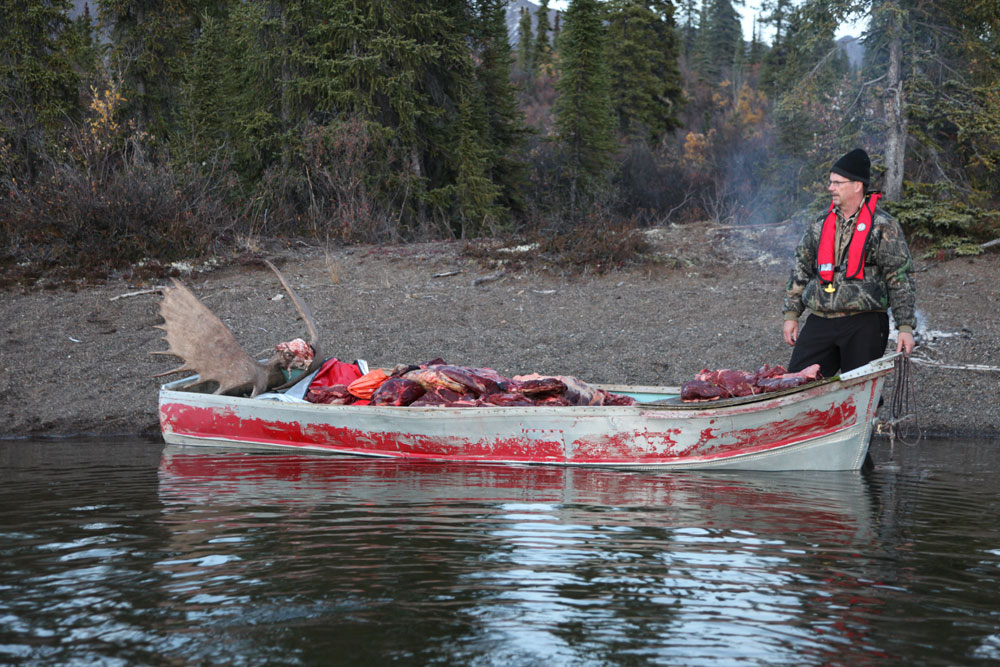
Fleece and Rain Suit
Anyone rarely goes on a hunting trip without some insulation layers and a good rain suit. Turkey, pheasant and even elk backstraps have made their way home in luggage. Ideally, meat should be frozen or at least cold to the touch. An industrial-weight garbage bag starts the layering, followed by base-layer garments, a fleece jacket or an insulated vest. A rain suit is a final layer before tucking everything in the suitcase with other clothing and personal items. As long as there isn't a long trip home from the airport, the meat is usually the same temperature as when you left the hunting camp.
Flight Considerations
When flying home as a successful hunter, always check first-class upgrades and availability. Depending on the airline, first-class passengers may be allowed two checked bags up to 70 pounds. It is often more economical to upgrade and have extra luggage than extra baggage fees on regular cabin fares. Use airline apps for a smartphone to check availability online before getting to the airport. The best deals are usually within 24 hours of travel.
Airline-Approved Coolers or Carry-on
Always check with airlines for the size of carry-on items allowed and restrictions for meat or frozen items. Weight restrictions and cost are easy to find ahead of time to decide if flying meat home is the best option.
Keep in Mind
The Transportation Security Administration (TSA) will inspect bags with meat products. Package everything knowing it will be inspected and should be quickly closed without damaging individual packaging or losing too much cold. You can often watch bags pass through an X-ray, and dense items, like meat, are a required check.
Whole or Parts
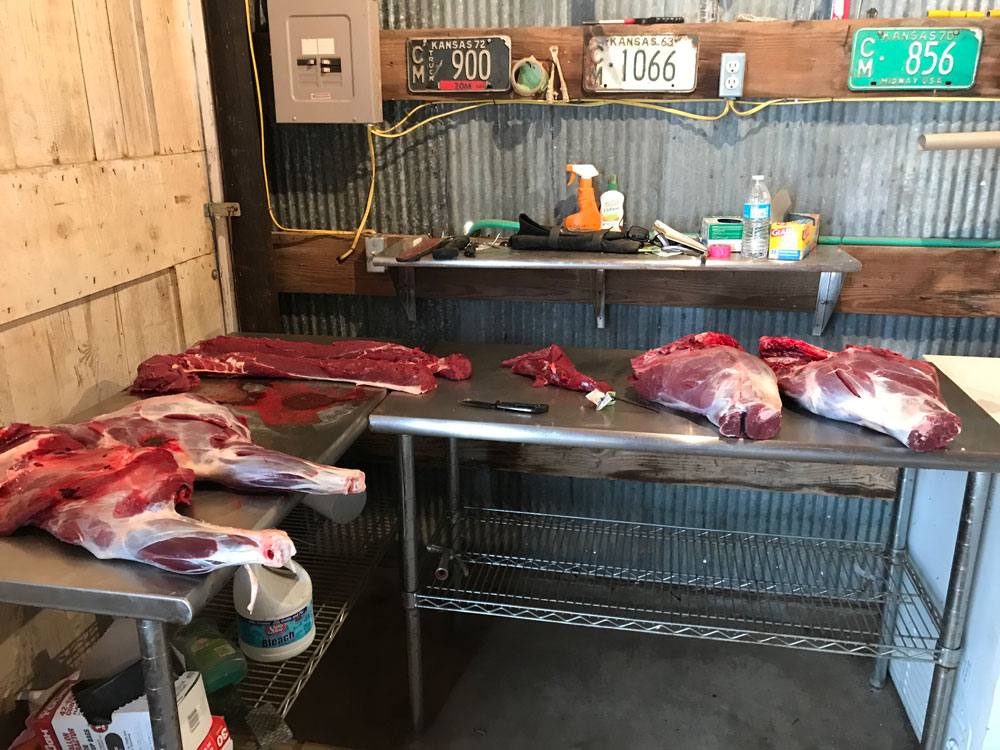
Whether driving, flying or shipping meat, always consider reducing weight and bulk by only transporting meat and leaving bones behind. It is a good practice, especially with Chronic Wasting Disease concerns and not transporting brain and spinal material across a state, provincial or international border. It is a good reminder to clean skulls before transporting them home, as well.
Temperature Considerations
The best temperature for aging is between 38-40°F, as it allows the tenderizing enzymes to be more active yet stall the growth of harmful bacteria. Staying below 40°F is a must to delay the growth of bad bacteria that causes spoilage. Meat freezes at about 28°F, allowing hunters to store fresh meat for more extended periods after aging for when you have time to cut and wrap.
When a Butcher Makes Sense
Some outfitters do not allow hunters to butcher animals in camp, so a local butcher is often the only choice. Have a soft-sided cooler shipped to camp, anticipating success, and take the cooler in when you drop off the carcass. The meat can be cut, wrapped and frozen in the cooler, with an official weight to ensure no airline check-in counter problems.
The other benefit of having a butcher deal with wild meat before heading home is the ease to transition back to family duties. Walk in the door, stack wrapped packages of mule deer or turkey in the freezer and get caught up on sleep, laundry or what the clan has been doing while you've been slaving to bring home the winter larder.
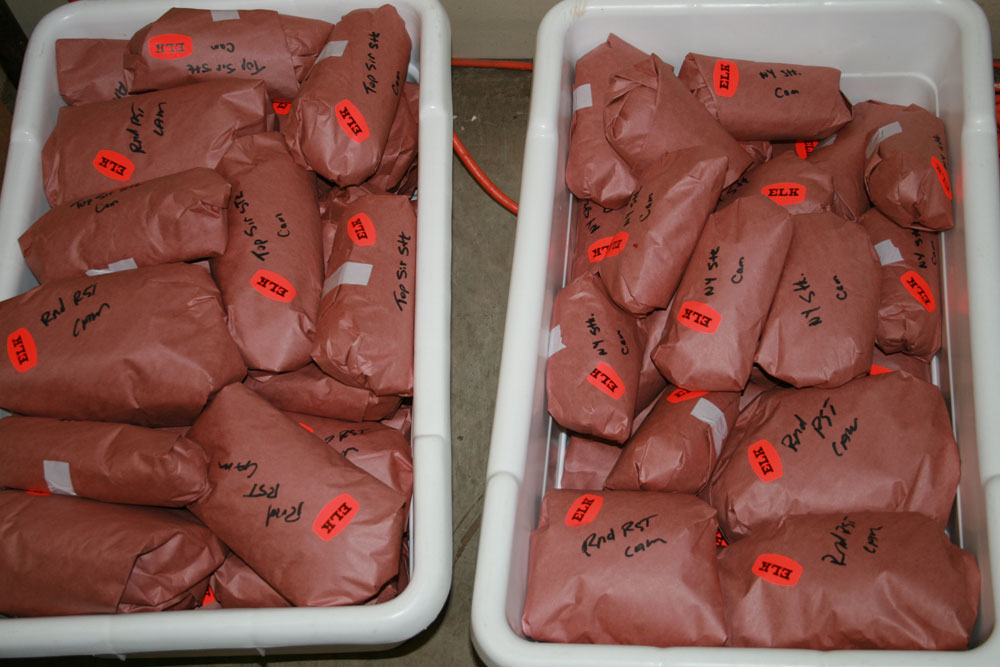
Shipping
There are shipping options for hunters wanting to use a company but look into an account and pricing before the trip. A cooler can be packed and dropped off for shipping, or arrangements made to pick it up right from camp. There are times when shipping is a good option, and several butchers will have pricing options if you are leaving meat for processing.
Bid on Shipping
Shipping Wars was a reality television show where people in need of ground transportation services could request bids to do the job. Private individuals and trucking companies bid to pick up your package and transport it for a set price. Several websites have shipping companies bid on moving things like wild game, but always make sure you have the correct paperwork for moving wildlife parts. If a copy of your license is not enough, an export permit may be required.
Tags, evidence of sex, species and other regulations may require paperwork besides a license. Check with the local Fish and Game Department to make sure you are legal when moving meat, antlers, horns, birds or anything else. Crossing state or international borders can be easy, but always know the requirements to prevent enforcement issues.
How to Wrap Meat to Prevent Leaks and Freezer Burn
Raw meat can be vacuum-sealed to ensure it does not leak. Readers can get 20 percent off at Weston Brands by entering BFENSON21 at checkout. There is a good selection of vacuum and chamber sealers, along with rolls and pre-made bags for any sealer. Entire loins and muscle groups, like sirloin tip and outside round, can be packaged whole. Frozen meat can thaw at home, age and then be cut. Dry-age bags are a good option. Suppose you process lots of meat on an annual basis. In that case, a Koola Buck is a great consideration, with two different sizes of portable meat coolers that can be taken to camp or set up when you get home to hang and age meat perfectly.
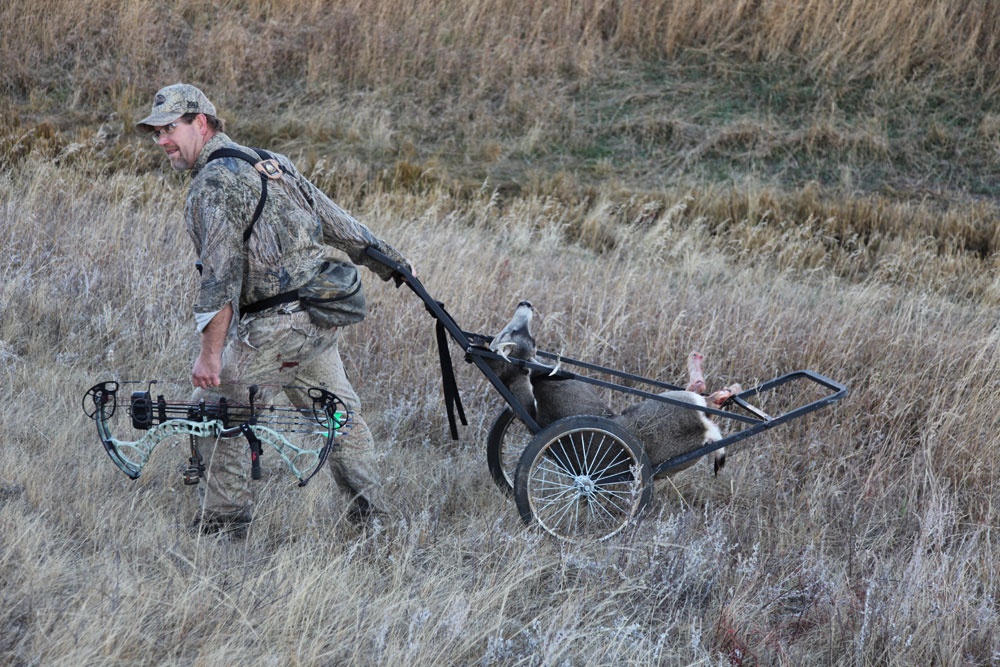
Tough Decision
The size of an animal may come with a restriction on the volume of meat to move. An antelope is pretty easy to pack in a small cooler and head home. A large mule deer, elk or moose can create challenges if you want to take all of the meat. If you have to make a choice, concentrate on the prime cuts. Backstraps, tenderloins, sirloins or other favorite cuts should top your list.
Road Kit
Make a portable road kit for butchering and packaging game meat. Resonite or plastic wrap, waxed meat wrapping paper, masking tape, marking pen, cutting board and a cooler are great ways to do it yourself before heading home. Outdoor Edge has a Game Processing Kit and smaller versions for hunters with the time and ambition to butcher independently.
Meat Wrapping Tip
When wrapping meat, use Resonite or plastic wrap to seal the meat, pushing all the air out of the package before pulling the ends over to seal. Then, wrap in waxed butcher paper, folding the corners in to ensure all the air is pushed out. Tape to hold the paper in place. Meat double-wrapped with the plastic base layer will provide at least 24 months of freezer life.
The Successful Hunting Adventure
Hunting trips abroad are some of the most memorable adventures you can have. Exploring different parts of the country and the game that lives there are memories that last a lifetime. You don’t want spoiled meat to ruin those memories. Whether preparing meat for your family or giving it away to friends, you can be proud of your adventure and the bounty you brought home. The tips and tricks we have discussed will get your meat home safe and sound.

Need wild game meat for a recipe you've been wanting to try? Check out GameKeeper Butchery. GameKeeper Butchery is dedicated to procuring the finest assortment and highest quality of specialty meats from the United States and around the world. Our commitment is to deliver the safest, freshest and most wholesome products.
















